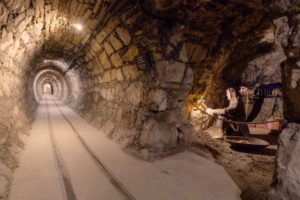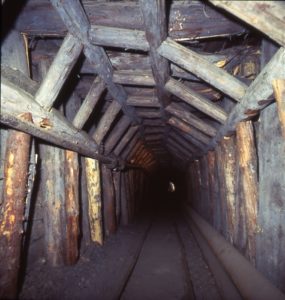The Idrija mercury mine was one of the world’s largest producers of mercury and cinnabar (end of production in 1995), surpassed only by the Spanish Almadén mine (end of production in 2003). The majority of the population in Idrija made a living from mining from generation to generation. For five hundred years, Idrija miners burned mercury ore at high temperatures so that mercury would evaporate from it and liquefy it again in the cold. In ores it mostly appears as cinnabarite or as native mercury.

THE ANTHONY’S TRENCH IS THE OLDEST PRESERVED ENTRY INTO THE MERCURY MINE IN IDRIJA AND ONE OF THE OLDEST IN EUROPE. IT IS NAMED AFTER ST. ANTON PADOVANSKI, CAVE PROTECTOR AND PROTECTOR AGAINST ACCIDENTS. SINCE 1994, IT HAS BEEN ARRANGED FOR TOURS (SOURCE: CUDHG IDRIJA).
The only liquid metal – mercury is extremely harmful and in the form of organic compounds also toxic. This is why it has been replaced in the industry by other substances. Mercury was and still is used in some places today for the production of industrial chemicals, in electronic devices, in telescopes, as well as in energy-saving light bulbs, as it is a good conductor of electricity. It dissolves gold, zinc, aluminum and other metals and forms amalgams (lat. Alloys with mercury).

EXCAVATED TRECHES WERE FORTIFIED WITH WOOD FROM THE SURROUNDING HILLS (SOURCE: CUDHG IDRIJA)
The mercury trade was just as important as its production. Various European merchants became rich with it, and after 1659 the mercury trade was taken over by the Viennese court chamber.
The Heritage of Mercury was inscribed on the UNESCO World Heritage List in 2012.
Interesting:
Mercury is the only metal that is in a liquid state at normal temperature and pressure.

Comments are closed